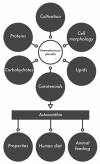Astaxanthin and other Nutrients from Haematococcus pluvialis-Multifunctional Applications
- PMID: 32906619
- PMCID: PMC7551667
- DOI: 10.3390/md18090459
Astaxanthin and other Nutrients from Haematococcus pluvialis-Multifunctional Applications
Abstract
Bioactive compounds of natural origin are gaining increasing popularity. High biological activity and bioavailability, beneficial effects on health and safety of use are some of their most desirable features. Low production and processing costs render them even more attractive. Microorganisms have been used in the food, medicinal, cosmetic and energy industries for years. Among them, microalgae have proved to be an invaluable source of beneficial compounds. Haematococcus pluvialis is known as the richest source of natural carotenoid called astaxanthin. In this paper, we focus on the cultivation methods of this green microalga, its chemical composition, extraction of astaxanthin and analysis of its antioxidant, anti-inflammatory, anti-diabetic and anticancer activities. H. pluvialis, as well as astaxanthin can be used not only for the treatment of human and animal diseases, but also as a valuable component of diet and feed.
Keywords: Haematococcus pluvialis; applications; astaxanthin; microalgae.
Conflict of interest statement
The authors declare no conflict of interest.
Figures




References
-
- Ariede M.B., Candido T.M., Morocho-Jacome A.L., Baby A.R. Cosmetic attributes of algae—A review. Algal Res. 2017;25:483–489. doi: 10.1016/j.algal.2017.05.019. - DOI
-
- Molino A., Iovine A., Casella P., Mehariya S., Chianese S., Cerbone A., Rimauro J., Musmarra D. Microalgae characterization for consolidated and new application in human food, animal feed and nutraceuticals. Int. J. Environ. Res. Public Health. 2018;15:2436. doi: 10.3390/ijerph15112436. - DOI - PMC - PubMed
Publication types
MeSH terms
Substances
LinkOut - more resources
Full Text Sources
Other Literature Sources
Medical

